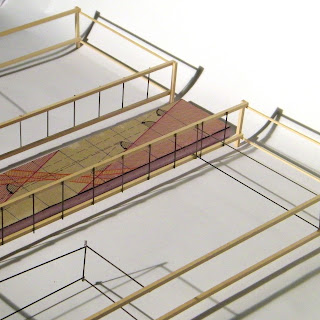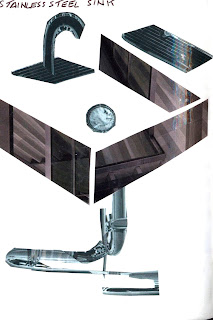Wednesday, May 4, 2011
Wednesday, April 6, 2011
Tuesday, March 22, 2011
Sense of Site: Interpretation of Readings
When do all of the senses come work together to create a unified whole? What is this golden combination which creates a unanimous whole between the bodies involved in the architecture? Our human body not only is a tool to measure the body of a structure but an interpreter of the space as an experience. Pallasmaa conjures up an environment where the body measures with strides, physical force and sight. With this, Pallasmaa’s body and the cathedral’s body interact and exchange a dialogue of measures which delves into the inferred monumental nature of the structure. Only when his senses are combined and he interacts with the space does the experience/structure become something worth remembering. This memorable quality could, in essence, be labeled as “atmosphere.”
Inviting or repelling qualities can exist in this atmosphere. How does architecture orientate and direct the senses with these qualities? The mind infers information from the senses which creates an immense imaginary realm. In this place, we find invitations to venture forward or to rest in peace when we find comfort. The atmosphere we discover with our senses becomes a place beckoning to us in good instances and repelling us in the worst of instances. In one example, Zumthor used light to attract users to different spaces on the site. Though the design does not channel the users via forced path, each individual still meanders from space to space and are rewarded with the memorable experience of the baths. . Eyes read the light as an invitation, the sight becoming part of the atmosphere. In this way, the sight becomes a wealth of inferred knowledge about the environment the user is exposed to.
How much of a site does sight read? Our eyes are more than organs for seeing; they become organs for reading space and its environment. With the inference of information and the imaginary world sight can create, we read into form and create a detailed description of place. In essence, sight can create a depth of information gleamed from a short-lived glance. Pallasmaa describes his fascination with the threshold of the James Residence designed by Greene & Greene and his want to taste the white marble. Bizarre as this desire is, this case speaks of the power our eyes hold. With sight, we imagine this world of taste, smell and sound. Though the other senses come into play when the user “reads” the site, vision works to the best advantage.
Zumthor delves into a short discussion of first impressions and their importance. In the end, he comes to the conclusion that a high quality first impression is a necessity for memorable architecture. Without this immediate grasp, the site or the structure has not captured what could be considered a memorable atmosphere. A great deal of a first impression is based on appearance, the glance with which the average user digests the space for an immediate reading of popular versus unpopular.
However, the other senses work with this vision to create the first impression. Pallasmaa’s interaction with the imagined cathedral created a first impression of mass and strength with a pleasing quality in contours of the façade. Without the weight of the doors to the cathedral and the visual of the massing, the structure would remain lifeless and lack a memorable quality. In this moment alone Pallasmaa utilizes touch, sight, movement and proportion to experience the place. He dissects these actions to describe them, however they happen in unison. In my own mind I can envision the strides he takes to the door, looking above him at the cathedral, and following through with the motion to utilize the threshold; it is a sensation each reader can break down into parts as a common memory. In the unity of this motion to enter the cathedral is the experience, not the cathedral in of itself. The cathedral’s façade and construction simply create the backdrop for the user, Palasmaa, to experience.
Inviting or repelling qualities can exist in this atmosphere. How does architecture orientate and direct the senses with these qualities? The mind infers information from the senses which creates an immense imaginary realm. In this place, we find invitations to venture forward or to rest in peace when we find comfort. The atmosphere we discover with our senses becomes a place beckoning to us in good instances and repelling us in the worst of instances. In one example, Zumthor used light to attract users to different spaces on the site. Though the design does not channel the users via forced path, each individual still meanders from space to space and are rewarded with the memorable experience of the baths. . Eyes read the light as an invitation, the sight becoming part of the atmosphere. In this way, the sight becomes a wealth of inferred knowledge about the environment the user is exposed to.
How much of a site does sight read? Our eyes are more than organs for seeing; they become organs for reading space and its environment. With the inference of information and the imaginary world sight can create, we read into form and create a detailed description of place. In essence, sight can create a depth of information gleamed from a short-lived glance. Pallasmaa describes his fascination with the threshold of the James Residence designed by Greene & Greene and his want to taste the white marble. Bizarre as this desire is, this case speaks of the power our eyes hold. With sight, we imagine this world of taste, smell and sound. Though the other senses come into play when the user “reads” the site, vision works to the best advantage.
Zumthor delves into a short discussion of first impressions and their importance. In the end, he comes to the conclusion that a high quality first impression is a necessity for memorable architecture. Without this immediate grasp, the site or the structure has not captured what could be considered a memorable atmosphere. A great deal of a first impression is based on appearance, the glance with which the average user digests the space for an immediate reading of popular versus unpopular.
However, the other senses work with this vision to create the first impression. Pallasmaa’s interaction with the imagined cathedral created a first impression of mass and strength with a pleasing quality in contours of the façade. Without the weight of the doors to the cathedral and the visual of the massing, the structure would remain lifeless and lack a memorable quality. In this moment alone Pallasmaa utilizes touch, sight, movement and proportion to experience the place. He dissects these actions to describe them, however they happen in unison. In my own mind I can envision the strides he takes to the door, looking above him at the cathedral, and following through with the motion to utilize the threshold; it is a sensation each reader can break down into parts as a common memory. In the unity of this motion to enter the cathedral is the experience, not the cathedral in of itself. The cathedral’s façade and construction simply create the backdrop for the user, Palasmaa, to experience.
Monday, March 21, 2011
ALLEY DOCUMENT SYNOPSIS
TOOL - PHYSICAL RELATION TO THE BODY
HUMAN SCALE RELATING TO THE HAND
MOTION RELATING TO THE BODY
TIME LINE - TIME RELATING TO EVENTS
EVENTS RELATING TO HUMAN
HUMAN RELATING TO TOOL VIA MOTION
FLOOR PLAN - SCALE OF TOOL MOTION RELATING TO BODY OF STRUCTURE
STRUCTURE RELATING TO SITE
Sunday, February 27, 2011
Friday, February 18, 2011
Sketch Book Collages
RUSH-HOUR TRAFFIC
1/14
CHATTERING CALL CENTER
1/19
OUTER-SPACE
1/21
FUNERAL WHISPER
1/24
SOLO TAP PERFORMANCE
1/26
STADIUM SPORT EVENT
1/28
WALKING ON THIN ICE
1/31
WOOD FLOORING
2/2
CONCRETE ROOM
2/4
TIN BARN
2/7
CANVAS TENT
2/9
MARBLE STAIRWELL
2/11
STAINLESS STEEL SINK
2/14
GLASS SMOKING ROOM
2/16
POLYCRYLIC TABLE
2/18
1/14
CHATTERING CALL CENTER
1/19
OUTER-SPACE
1/21
FUNERAL WHISPER
1/24
SOLO TAP PERFORMANCE
1/26
STADIUM SPORT EVENT
1/28
WALKING ON THIN ICE
1/31
WOOD FLOORING
2/2
CONCRETE ROOM
2/4
TIN BARN
2/7
CANVAS TENT
2/9
MARBLE STAIRWELL
2/11
STAINLESS STEEL SINK
2/14
GLASS SMOKING ROOM
2/16
POLYCRYLIC TABLE
2/18
Subscribe to:
Comments (Atom)





























































